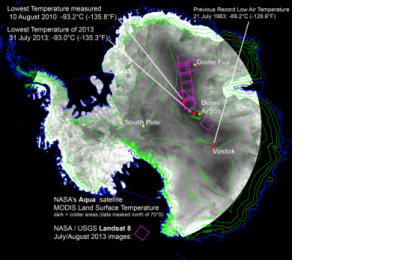United
Nations
Office for Outer Space Affairs
UN-SPIDER Knowledge Portal
NASA's Landsat 8 satellite defined the coldest place on Earth - a high ridge in Antarctica on the East Antarctic Plateau where temperatures in several hollows can dip below minus 133.6 degrees Fahrenheit (minus 92 degrees Celsius) on a clear winter night.
Scientists from NASA evaluated 21 years’ worth of data, including the most detailed global surface temperature maps, developed with data from remote sensing satellites. They found that the temperatures were record low many times between Dome Argus and Dome Fuji, but the new record was set on 10 August 2010.
The launch of the new satellite Landsat 8 finally gave the researchers the sensor that allows them to investigate the area more precisely. For the analysis they used the Moderate Resolution Imaging Spectroradiometer (MODIS) instruments on NASA's Terra and Aqua satellites and the Advanced Very High Resolution Radiometer (AVHRR) on several National Oceanic and Atmospheric Administration satellites. The sensitivity of these instruments enables them to register any thermal radiation.
NASA hopes to use Landsat 8 to make more accurate and detailed maps of the landscape and be able to detect any changes much earlier.
